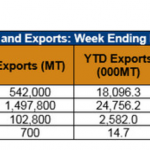This Week in the Legislature—This week, the House Committee on Natural Resources met for the first time to discuss committee rules and hear general testimony from the Texas Commission on Environmental Quality (TCEQ) and the Texas Water Development Board. The rest of this week’s hearings in the House were primarily budget-related in nature. The Senate Committee on Natural Resources and Economic Development also met to discuss committee rules and hear general testimony from state agencies, but also to hear testimony on SB 26. SB 26 is a bill that reforms funding mechanisms for the Texas Emissions Reduction Plan (TERP), but also has language that may compromise elements of the ethanol industry in Texas. Earlier in the week, the Senate Committee on Agriculture, Water & Rural Affairs met for the first time to discuss committee rules and to discuss veterinary care in rural Texas now that the Texas Tech vet school plan has been halted. The legislature is now just a week away from being able to hold hearings for bills that were not designated as emergency items by leadership, so expect a significant uptick in committee activity in both the House and the Senate moving forward.
New Advancements in Sorghum Breeding Technology—A three-year research collaboration effort between the United Sorghum Checkoff Program and DuPont Pioneer has yielded a major new tool for sorghum improvement. DuPont Pioneer research scientists, led by Cleve Franks and Tanveer Hussain, discovered two sorghum haploid inducer lines. The first of its kind, these patent-pending inducer lines enable the creation of doubled haploid sorghum, which is the first step to significantly accelerating the sorghum breeding process. The United Sorghum Checkoff Program funded the Pioneer research as part of a three-year, $800,220 investment. The research, conducted in Texas, Kansas, Puerto Rico, Mexico and Iowa, leveraged the world-class, global breeding programs of Pioneer. The results and developments from the collaboration will be available for out licensing.
Demonstrating Grain Sorghum Potential in Texas: Using Best Management Practices to Maximize Yield and Economic Return—Grain sorghum yields overall in Texas have not increased much since the 1970’s. Yet, statewide data does not accurately describe sorghum potential in Texas. Using actual yield measurements from AgriLife trials, yield trends have increased in some regions but has not been equal across the state. Large yield increases (1.6 bu/acre/yr) have been observed in the High Plains region under irrigation while other regions have had little if any increase in yield. National Sorghum Yield Contest and other yield reports from regions with lower yield trends suggest that much greater yield potential does exist. Greater than 200 bu/acre was obtained in central Texas during 2014 while many growers are content with less than 100 bu/acre. Research/demonstration plots were established within three major sorghum production regions of Texas to compare production systems with varying yield goals and inputs. Best management practices were used to ensure adequate weed, insect and disease control. Increasing nitrogen fertilizer rates were used to determine optimum yield potential. Environmental conditions were a major constraint for grain yield during 2016 across all three regions. Excessive rainfall reduced tiller production and limited grain yield. Furthermore, residual soil nitrogen (N) at all sites reduced N fertilizer response and lowered economic return for added N fertilizer. Ultimately, unusual weather conditions limited yield potential precluding the demonstration of true sorghum yield potential. Principal Investigator: Ronnie Schnell, Other Investigators: T. Provin, J. Mowrer
Market Perspectives–Sorghum: Net sales of 16,200 MT for 2016/2017 were down 81 percent from the previous week and 78 percent from the prior 4-week average. Increases were for China (51,700 MT, including decreases of 1,300 MT), the Republic of South Africa (49,500 MT, including 42,500 MT switched from unknown destinations), Japan (10,000 MT), and Taiwan (500 MT). Reductions were reported for unknown destinations (95,500 MT). Exports of 102,800 MT were down 42 percent from the previous week and 30 percent from the prior 4-week average. The destinations were China (51,700 MT), the Republic of South Africa (49,500 MT), Indonesia (900 MT), and Mexico (600 MT).










